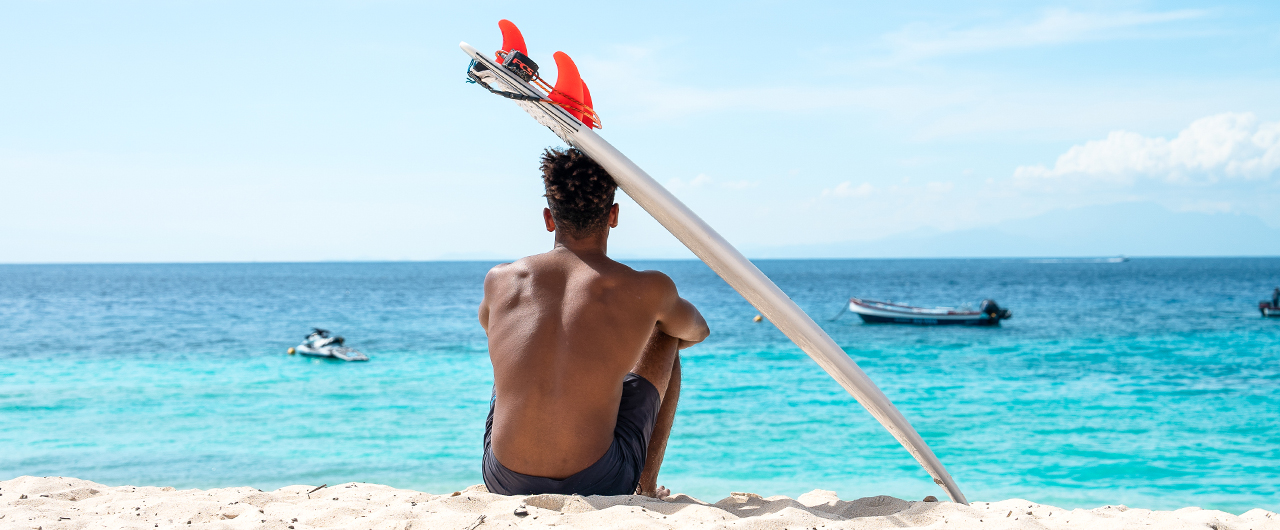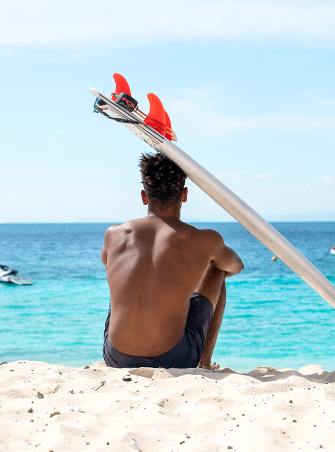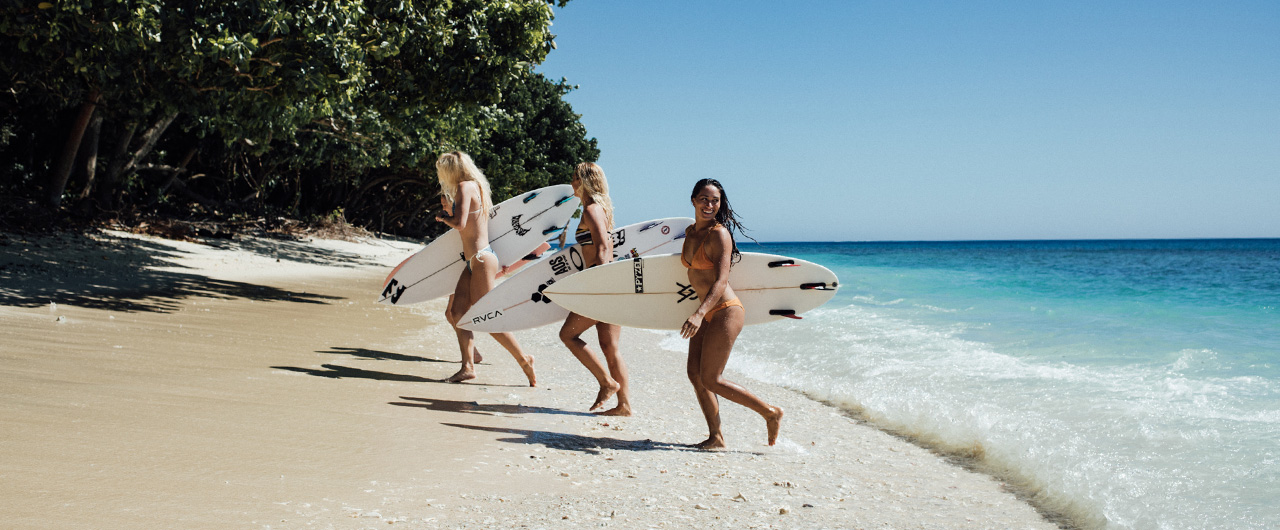Surfing Fiji 101: Your Ultimate Guide


Surfing Fiji 101: Your Ultimate Guide to Surfing Waves in Paradise
When is the best time to surf in Fiji?
One of the best things about Fiji is the warm ocean temperatures and the consistency of its waves. While April and May are often considered optimal, excellent surfing conditions can be found anytime.
Generally, April – November has the most consistent swell, while May- September also offers trade winds, particularly in the afternoon.
Between November and March, there's an increased chance of tropical storms and, occasionally, cyclones. Still, the flipside of this is a quieter line-up and longer, glassier days. For the Coral Coast, this time of year is peak season when you'll find excellent, glassy waves.

Where can I find the top surf breaks and hidden gems?
Mamanuca Islands - Some of the most famous waves in Fiji can be found in the southern Mamanuca Islands; a chain of around 20 islands just off the coast of Nadi in western Fiji. Access from nearby Tavarua, Namotu and other resorts on Malolo-lailai and Malolo is simple, but you can also reach the waves from Nadi through local surf charter companies.
Most notable among this collection of world-class waves is Cloudbreak, famous for gracing magazine covers, surf films and as the home of the Fiji Pro competition in the WSL tour.
Nearby, Restaurants, Wilkes, Tavarua Rights, Swimming Pools and Namotu Lefts are equally impressive giving you a diverse choice of lefts, rights, solid, and small waves, under slightly different conditions. It's this diversity and accessibility that make this region the most popular and accessible surf destination in Fiji.
Coral Coast
The southern coast of Viti Levu picks up southerly swells. These low-pressure systems form in the Tasman Sea and travel north to Fiji, where they break along the Coral Coast. This region boasts several world-class breaks, most notably Frigates and Fiji Pipe. These waves are slightly more secluded but worth the journey, tending to offer uncrowded line-ups all year. If you’re willing to go the extra mile, this region will reward you with big barrels, beautiful reef passes, and crisp Fiji lagers.
Resorts such as Matanvusi, Fiji Beachouse and Waidroka Bay offer surf trips and packages. It's worth noting that trade wind season can be felt more acutely in this part of Fiji; therefore, this area's best season is from December to March. During this time, waves like J's, Shifties and Vunaniu start firing with winds coming from the north. Fortunately, Frigates and Pipe are offshore in the prevailing southeasterly winds, so you'll find decent waves in this part of Fiji any time of year.
Surfing for Beginners
Fiji welcomes beginners with open arms! Experience smaller, beginner-friendly waves like the ones at Natadola Beach alongside equally friendly surf instructors. Get in touch with Endless Summer, Fiji Surf Co, Waitui Watersports Fiji, Brothers Surf Tours or Dream Surf Fiji for lessons and charters.
While some waves, including Cloudbreak, require more experience, there are options for all skill levels across the regions and any time of year.

Your Equipment: Bring or Rent?
Consider bringing your equipment for convenience, though many surf resorts and operators provide rentals. Confirm availability with your tour guide or resort before your trip to ensure they have the right equipment to suit your needs.
Navigating to the Waves
Accessing the waves depends on your location. Specialised surf resorts offer surf boats, either included or at an extra cost. Other resorts and hotels can help arrange charters with external operators. Plan according to your stay and in advance
Surfing Safety in Fiji
Prioritise safety by staying within your skill level. Fiji's conditions vary from knee-high to "big wave" territory so if in doubt, don't paddle out. Consult your surf guide or boatman for local knowledge, the best tides and times, and potential hazards.
Remember to pack a basic first aid kit, all your personal medications, reef-safe sunscreen and protective clothing like booties, wetsuit tops and hats. Although Nadi has medical facilities and pharmacies, access to these essentials can be tricky out of town. Some resorts are well-equipped with first aid rooms, medivac and even on-site medics, but most only have limited first aid facilities.
Reef cuts are common when surfing, but most will heal well if washed and treated with hydrogen peroxide or iodine immediately. If left untreated, these can become infected and develop into a severe Staf infection requiring specialist treatment. As always, early treatment or prevention is vital.
Other hazards include sunburn, dehydration and the occasional jellyfish sting. Covering up, wearing reef-safe sunscreen, and packing a water bottle, electrolytes, and personal medications such as Epi-pens is advised. More serious laceration injuries can occur, and treatment is available at the hospital or private facilities in Nadi.
Travel insurance is absolutely essential so make sure to check the fine print so all your activities are covered. Some policies do not cover water sports.

Wave Size and Forecast
Wave sizes range from knee-high to triple overhead, influenced by weather and tides. Expect shoulder-high to overhead waves most often but check forecasts for accurate predictions.
How much does it cost to surf in Fiji?
Accommodation options in Fiji cater to various budgets, ranging from $200FJD per night to luxury villas up to $25,000USD per night. Surf trips can be included at an all-inclusive resort or are usually an additional expense, ranging from several hundred to over a thousand dollars per trip, depending on the standard of guiding, boards and boats.
Embracing the Local Culture
Fiji's locals are known for their warmth, hospitality and big "Bula" smiles. Many incredible local surfers operate surf charter businesses or are employed by resorts. They are always eager to share their favourite breaks and provide excellent service for beginners through to advanced surfers. Wherever you go, remember to show the usual surfing etiquette, and always return a smile from the locals!
Can I Longboard & Paddleboard?
Absolutely! Fiji offers excellent waves for longboarding, often making it the ideal choice on many days.
Wave Diversity
Reef vs. Sandbar While many waves are reef breaks, Fiji also has several sandbar breaks. Reef breaks are preferred for their superior wave quality, but these more local destinations can be accessed by car.
Choosing the Right Surfboard
Bring your favourite board, rather than packing the 30lt performance board you haven't ridden in years. If you can, pack a couple of options to cover you in various conditions. Depending on your style, this might be the shortboard you enjoy in steeper, more critical waves plus a fun shape, mid-length or a longboard. Remember, hiring or buying boards in Fiji can be very limited, so a repair kit, spare legrope and multiple boards is a good idea.